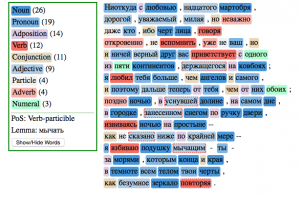Joseph Brodsky: Digital Humanities Lab was designed to establish and highlight creative use of the unique resources housed at the Beinecke archive, the Yale Slavic Department’s historical strengths in scholarship on modernist and émigré poetry, and a growing interest on the part of faculty, students, librarians, and staff to work collaboratively on teaching and research. Building from recent experiments in the Digital Humanities at Yale and other research centers, Joseph Brodsky: Digital Humanities Lab was created in hopes of designing a focused project that can serve as a forward-looking model for pedagogic, collaborative, and scholarly work.
The Beinecke houses the North American—and largest—collection of Nobel laureate and bilingual Russian émigré poet Joseph Brodsky’s materials, including numerous boxes of poetry, prose, translations, drafts, and letters. Only a small fraction has been digitized, much is not easily accessible, and the archive receives limited attention. Joseph Brodsky: Digital Humanities Lab worked with a course support team and a selective group of graduate and advanced undergraduate students to explore interfacing with the archive, the possibilities of a web-based scholarly environment, research tool design and creation, and collaborative contributions to Brodsky scholarship through the creation of a new online resource. The goal was to explore original materials, translations, and scholarship from multiple disciplinary angles, as well as to try new research tools in the hopes of producing original research, unprecedented both in cumulative quantity and style of approach.
Joseph Brodsky: Digital Humanities Lab intended to help students achieve practical, immediate goals while developing collaboratively a larger resource. Building on the established strengths of the Yale Slavic department, the experimental seminar aimed to push the envelope of critical investigations and respond to diverse student interests. Slavic department graduate students evinced interest in additional knowledge and training to give them a competitive edge on the job market, but also to learn skills transferable outside of Slavic or academic fields. Finally, the group hoped that the visibility of Joseph Brodsky: Digital Humanities Lab through conference participation, invited talks, and an online presence would help attract and recruit prospective graduate students, as well as raise undergraduate enrollment for the department.

Left: In this project, Jacob Lassin (GSAS ‘19) tagged Brodsky’s oeuvre for parts of speech and made the results accessible to class members on the web.
To accomplish these objectives, Professor Bozovic first met in the spring of 2014 with prospective course supporters: Peter Leonard, then the Librarian for Digital Humanities Research at Yale University Library; Lisa Conathan, then the Head of Processing at the Beinecke Library; and Trip Kirkpatrick, Senior Instructional Technologist in the Center for Teaching and Learning. After obtaining initial commitments of support, Professor Bozovic fleshed out needs over the summer, with the library taking the lead on collecting, digitizing, and OCRing, and standardizing a corpus of Brodsky’s published work. Next, the team determined specific responsibilities and, following Professor Bozovic’s draft syllabus, a progression of technologies that would give students a fair introduction to common possibilities for digitally mediated analysis of Brodsky’s life and works. We settled on chronologic data visualization, mapping, textual analysis, and topic modeling, and integrated instruction and discussion of these into the syllabus. Each class session was roughly evenly split into discussion of Brodsky’s work based on direct reading and examination of technology-enabled approaches. As the semester progressed, course supporters and Professor Bozovic scaffolded students in their conceptualization and construction of final projects. The term culminated in an open symposium, during which the students presented and discussed their work with an audience including faculty and graduate students from Slavic and other humanities departments, librarians, staff, undergraduate students, and others.
Principally, the course resulted in several remarkable student projects operating on the Brodsky papers and digital corpus. One student mapped Brodsky’s path of exile, eliding common markers of nationality from the map and interrogating the writer’s trajectory. Another embarked on an ambitious attempt to create an algorithm for detecting the feminine rhyme scheme beloved by Brodsky and evidenced in his fraught collaborations with translators as well as in his painstaking self-translations. One student’s project, using Voyant to analyze Brodsky’s vocabulary of astronomical and celestial phenomena, was presented at Re:Humanities 2015, a national undergraduate Digital Humanities conference. Finally, students also engaged in thoughtful criticism of the limitations of Digital Humanities methods through close readings of Brodsky’s work infeasible with known algorithmic approaches.

Ingrid Nordgaard (GSAS ‘20) plotted poet Joseph Brodsky’s mentions of fauna — including fictitious hybrids — over his lifetime.
The diversity of student projects shows the success of Professor Bozovic’s encouragement and support for a panoply of interpretations of literary work as well as perspectives on Digital Humanities. It also shows the fertile field for pursuing similar pedagogical projects using other authors, histories, textual corpora, or literary movements. Joseph Brodsky: Digital Humanities Lab was intended to serve as a model for other projects, an example of how not only to preserve but to revive—to work creatively, pedagogically, and productively with—materials that could otherwise drift into disuse and obscurity outside of a small group of specialists.
Joseph Brodsky: Digital Humanities Lab will serve as the basis for the development of a larger course and research initiative with expanded and more diverse coverage, Avant-Gardes and Émigrés: Digital Humanities and Slavic Studies, planned for the fall of 2016. All members of the team welcome questions about the project and the incorporation of digital textual analysis into coursework.
